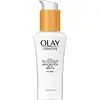What's inside
What's inside
 Key Ingredients
Key Ingredients

 Benefits
Benefits

 Concerns
Concerns

 Ingredients Side-by-side
Ingredients Side-by-side

Ethylhexyl Methoxycinnamate 7.5%
UV AbsorberEthylhexyl Salicylate 2.5%
UV AbsorberOctocrylene 2.5%
UV AbsorberZinc Oxide 7%
Cosmetic ColorantWater
Skin ConditioningIsohexadecane
EmollientGlycerin
HumectantNiacinamide
SmoothingPanthenol
Skin ConditioningCamellia Sinensis Leaf Extract
AntimicrobialTocopheryl Acetate
AntioxidantAloe Barbadensis Leaf Extract
EmollientSteareth-21
CleansingCyclopentasiloxane
EmollientPolyacrylamide
Stearyl Alcohol
EmollientPolymethylsilsesquioxane
Polyethylene
AbrasiveC13-14 Isoparaffin
EmollientBehenyl Alcohol
EmollientDMDM Hydantoin
PreservativeCetyl Alcohol
EmollientTriethoxycaprylylsilane
PEG/PPG-20/20 Dimethicone
EmulsifyingLaureth-7
EmulsifyingSteareth-2
EmulsifyingOleth-3 Phosphate
Disodium EDTA
Iodopropynyl Butylcarbamate
PreservativeEthylhexyl Methoxycinnamate 7.5%, Ethylhexyl Salicylate 2.5%, Octocrylene 2.5%, Zinc Oxide 7%, Water, Isohexadecane, Glycerin, Niacinamide, Panthenol, Camellia Sinensis Leaf Extract, Tocopheryl Acetate, Aloe Barbadensis Leaf Extract, Steareth-21, Cyclopentasiloxane, Polyacrylamide, Stearyl Alcohol, Polymethylsilsesquioxane, Polyethylene, C13-14 Isoparaffin, Behenyl Alcohol, DMDM Hydantoin, Cetyl Alcohol, Triethoxycaprylylsilane, PEG/PPG-20/20 Dimethicone, Laureth-7, Steareth-2, Oleth-3 Phosphate, Disodium EDTA, Iodopropynyl Butylcarbamate
Water
Skin ConditioningIsopropyl Myristate
EmollientCaprylic/Capric Triglyceride
MaskingMyristyl Alcohol
EmollientC14-22 Alcohols
Emulsion StabilisingGlycerin
HumectantCetyl Alcohol
EmollientButyrospermum Parkii Butter
Skin ConditioningPrunus Amygdalus Dulcis Oil
Skin ConditioningHoney
HumectantXylitylglucoside
HumectantPhenoxyethanol
PreservativeHydroxyethyl Acrylate/Sodium Acryloyldimethyl Taurate Copolymer
Emulsion StabilisingC12-20 Alkyl Glucoside
EmulsifyingMyristyl Glucoside
CleansingSodium Ascorbyl Phosphate
AntioxidantTocopheryl Acetate
AntioxidantIsohexadecane
EmollientAnhydroxylitol
HumectantHippophae Rhamnoides Fruit Oil
Skin ProtectingParfum
MaskingXylitol
HumectantCeramide Ng
Skin ConditioningGlucose
HumectantCitric Acid
BufferingPolysorbate 60
EmulsifyingEthylhexylglycerin
Skin ConditioningSodium Phytate
Sorbitan Isostearate
EmulsifyingVitis Vinifera Seed Extract
AntimicrobialWater, Isopropyl Myristate, Caprylic/Capric Triglyceride, Myristyl Alcohol, C14-22 Alcohols, Glycerin, Cetyl Alcohol, Butyrospermum Parkii Butter, Prunus Amygdalus Dulcis Oil, Honey, Xylitylglucoside, Phenoxyethanol, Hydroxyethyl Acrylate/Sodium Acryloyldimethyl Taurate Copolymer, C12-20 Alkyl Glucoside, Myristyl Glucoside, Sodium Ascorbyl Phosphate, Tocopheryl Acetate, Isohexadecane, Anhydroxylitol, Hippophae Rhamnoides Fruit Oil, Parfum, Xylitol, Ceramide Ng, Glucose, Citric Acid, Polysorbate 60, Ethylhexylglycerin, Sodium Phytate, Sorbitan Isostearate, Vitis Vinifera Seed Extract
 Reviews
Reviews

Ingredients Explained
These ingredients are found in both products.
Ingredients higher up in an ingredient list are typically present in a larger amount.
Cetyl Alcohol is a fatty alcohol. Fatty Alcohols are most often used as an emollient or to thicken a product.
Its main roles are:
Though it has "alcohol" in the name, it is not related to denatured alcohol or ethyl alcohol.
The FDA allows products labeled "alcohol-free" to have fatty alcohols.
Learn more about Cetyl AlcoholGlycerin is already naturally found in your skin. It helps moisturize and protect your skin.
A study from 2016 found glycerin to be more effective as a humectant than AHAs and hyaluronic acid.
As a humectant, it helps the skin stay hydrated by pulling moisture to your skin. The low molecular weight of glycerin allows it to pull moisture into the deeper layers of your skin.
Hydrated skin improves your skin barrier; Your skin barrier helps protect against irritants and bacteria.
Glycerin has also been found to have antimicrobial and antiviral properties. Due to these properties, glycerin is often used in wound and burn treatments.
In cosmetics, glycerin is usually derived from plants such as soybean or palm. However, it can also be sourced from animals, such as tallow or animal fat.
This ingredient is organic, colorless, odorless, and non-toxic.
Glycerin is the name for this ingredient in American English. British English uses Glycerol/Glycerine.
Learn more about GlycerinIsohexadecane is added to enhance texture, emulsify, and to help cleanse. It is an isoparrafin. It is a component of petrolatum.
Due to its large size, Isohexadecane is not absorbed by the skin. Instead, it sits on top and acts as an emollient. Emollients help keep your skin soft and smooth by trapping moisture within.
Isohexadecane is often used in products designed to help oily skin. It is lightweight and non-greasy while helping to moisturize. When mixed with silicones, it gives a product a silky feel.
Learn more about IsohexadecaneTocopheryl Acetate is AKA Vitamin E. It is an antioxidant and protects your skin from free radicals. Free radicals damage the skin by breaking down collagen.
One study found using Tocopheryl Acetate with Vitamin C decreased the number of sunburned cells.
Tocopheryl Acetate is commonly found in both skincare and dietary supplements.
Learn more about Tocopheryl AcetateWater. It's the most common cosmetic ingredient of all. You'll usually see it at the top of ingredient lists, meaning that it makes up the largest part of the product.
So why is it so popular? Water most often acts as a solvent - this means that it helps dissolve other ingredients into the formulation.
You'll also recognize water as that liquid we all need to stay alive. If you see this, drink a glass of water. Stay hydrated!
Learn more about Water